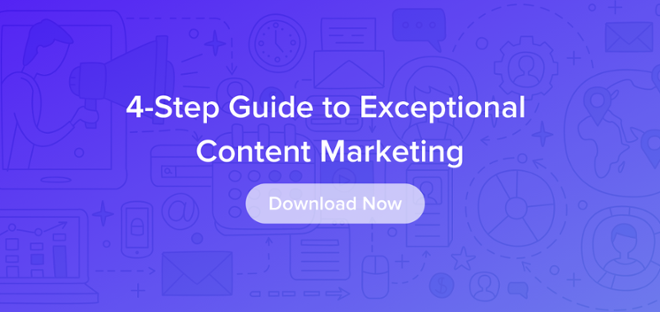 There's a reason 80 percent of B2B marketers have added blogging to their content marketing tool kit: It's one of the best ways to connect with audiences and become a trusted industry expert.
There's a reason 80 percent of B2B marketers have added blogging to their content marketing tool kit: It's one of the best ways to connect with audiences and become a trusted industry expert.
By effectively incorporating blogging into your content marketing strategy, you can generate more leads, engage readers in meaningful discussions, learn new things from colleagues and industry peers, build a name for yourself, and establish a better online position for your company.
But cementing your position as a trusted industry blogger involves more than simply brushing up on your writing. It takes time, effort, and a few key steps:
1. Identify topics your audience will find engaging.
For your blog content to be effective, it's got to be aligned with your ideal customers — in other words, your buyer personas. When you're brainstorming topics, consider what interests them and what pain points they're communicating to you and your sales team. Write about those things.
If you have multiple buyer personas and are speaking to various audiences, tailor different blog posts to those personas and stages of the buyer's journey. Maintain a healthy balance of educational content for the earlier stages of the journey and more promotional content to speak to your audience in the decision-making stage.
2. Deliver value.
When you first start your blog, it's tempting to pump out content simply to populate the page, but a fully stocked blog won't do much if readers don't find value in the content you're publishing. Creating evergreen and 10X (10 times better) content should be your primary concern.
The purpose of evergreen content is to maintain or even increase your blog traffic so your new posts get the attention they need. These posts could be guides, tutorials, lists of resources for your audience, etc. — valuable content that stays fresh and relevant for your audience over time.
10X content requires more time and effort, but done well, it can deliver great returns in terms of engagement, lead generation, and conversion rates. For your content to be 10 times better, it must:
- Be formatted to look great.
- Be interesting, useful, high-quality, and trustworthy.
- Educate or solve problems by including compelling statistics and illustrative personal examples.
- Communicate to all buyer personas and on several levels.
3. Find the right content mix to keep readers engaged.
Identifying topics and writing compelling headlines is only half the battle. Now, you have to find the perfect mix of content types to keep readers engaged through the end of each post. To do that, consider:
- Incorporating custom visuals to personalize your content.
- Using infographics to help readers visualize your message.
- Sharing valuable resources with relevant calls to action to further educate readers.
Avoid too much repetition here; offer educational content, but don’t forget to share something light and fun from time to time.
4. Speak directly with your audience.
There are few better places to source your next topic idea than the comments section of your blog or your social media posts. There, your readers will tell you what they think and what they want to read more about, and you have the chance to engage in meaningful conversations with them. Actively replying to questions or suggestions is also a great way to further humanize your brand.
5. Consider website design and SEO.
Being a B2B marketer, blogger, and optimizer is a daunting task. Fortunately, there are online guides that can help you start, run, and grow your online presence, even if you don’t have extensive technical knowledge.
You can get a blog up and running pretty easily using a premade theme and incorporating a few widgets. The SEO aspect of your blog, however, is something you want to pay active attention to. By following SEO best practices, your target readers have a better chance at finding your blog through search. To start, educate yourself on:
- The relationship between content and SEO.
- Long-tail keywords and how to place them.
- Mobile-friendly websites.
- Topic tags.
- Internal linking.
- Meta descriptions.
6. Leverage social media.
Social media plays a critical role in the online ecosystem. It's key in driving website traffic and building and engaging an audience, and Content Marketing Institute reports that 83 percent of B2B marketers incorporate social media into their content strategies.
Don't make your readers go on a wild goose chase to find the social media share icons within your blog posts. Instead, feature them near the top of the page, where they can be easily found (and clicked on). And distribute your content across your social platforms while you're at it to get more eyes on your blog and grow your community.
Looking for more ways to effectively distribute your content? 
7. Reward your engaged audience.
Include an option for readers to easily subscribe to your blog to enable people to keep up with your content. Once an engaged reader has subscribed, reward his or her loyalty by offering exclusive perks such as free e-books, premium content, and more in custom email drip campaigns. When the word gets out that you care for and appreciate your engaged readers, you'll attract new visitors to your blog, too.
8. Start guest posting.
Once you've established your own blog as a solid resource, consider guest blogging to reach new readers. Look for high-quality blogs and reputable online publications in your space that speak to your audience, and collaborate on guest-posting opportunities. (The golden rule for guest posting is to provide 10X content — something truly valuable and unique — that meets publication guidelines.)
9. Connect with industry influencers.
Influencers can be popular bloggers in your niche or renowned experts in the industry, and they all have what you are aiming for: your audience's trust. If industry influencers give you their stamp of approval, their audience will take note, and those feelings of trust will rub off on your brand, too.
Before you start identifying and connecting with influencers willy-nilly, though, make sure the influencer is a good fit for your brand. Do you speak to the same audience? Do you share the same values? These are all important things to consider.
Blogging is a powerful tool in any B2B marketer's kit, but it must be handled with care. Complete each of these steps, and you'll start to reap the full benefits of blogging.
Download our 4-step guide to ensure you're creating exceptional blog content!




 There's a reason
There's a reason




